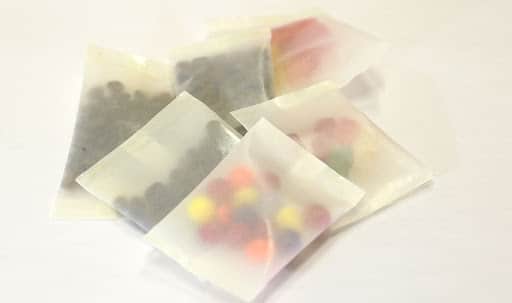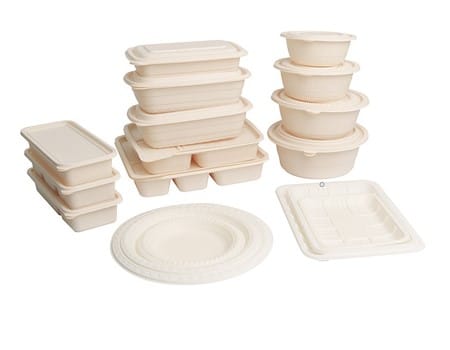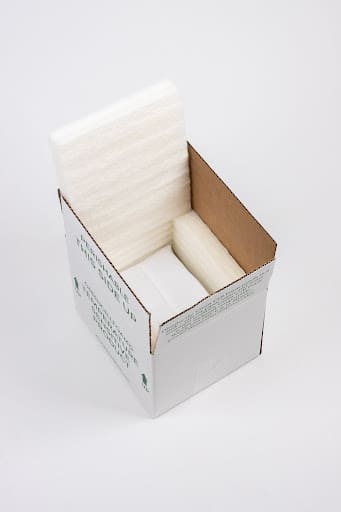There’s a strong chance your customers care about the environment. According to Trivium, 68% of consumers reported that they’d recently chosen a product based on its sustainability credentials.
The good news? If you show your commitment to sustainability, you’ll impress those eco-conscious customers and make them more likely to shop with your brand.
One of the best ways to go green is to invest in sustainable shipping packaging. In this guide, you’ll find the best sustainable packaging options available right now. You’ll also get our top tips on how to make your shipping more eco-friendly.
Offer customers 100% carbon-neutral shipping with Route
What is sustainable packaging?
Sustainable packaging is any environmentally friendly material used to wrap, store, ship, or shelve products. Eco-friendly packaging materials have a lower impact on the environment because they’re either recyclable, compostable, or biodegradable. They can be made from a range of things like cardboard or cornstarch.
Why offering sustainable packaging is critical for modern consumers
Consumers are 57% less likely to buy products in packaging they consider bad for the environment. 44% feel even stronger and say they “won’t buy” products in packaging that’s environmentally unsustainable. So, that’s a lot of customers you can attract with recyclable packaging.
Chris Bolman, CEO of Brightest, explains, “66% of consumers are willing to pay more for products from a socially responsible or sustainable brand, so there’s obvious pricing and brand incentive.”
People are becoming more conscious of the impact online shopping is having on the environment. Chris adds, “The majority of U.S. ecommerce customers care about climate change, the environment, and their own carbon footprint.”
Environmental sustainability isn’t just about new sales. It can help you build brand loyalty with existing customers too. As Chris puts it, “Easy options for more responsible consumption are always appreciated, and build brand goodwill and some incremental degree of loyalty.”
Sustainable packaging materials for shipping and ecommerce
The sustainable packaging market is expanding rapidly and is estimated to reach $444 billion by 2028. As a result, the range of sustainable packaging materials available has grown to include much more than paper and glass. To offer your customers the latest in eco-friendly shipping, let’s break down the variety of packaging options out there.
Compostable packaging
Compostable packaging decomposes naturally when left in a suitable environment. It’s usually made from three types of materials:
- Paper
- Cardboard
- Bioplastics
Since it’s made of organic materials, it doesn’t contaminate the environment with harmful chemicals. On the flip side, customers might not realize it’s meant for composting, not recycling, and only has a shelf-life of 9 months.
Recycled packaging
Recycled packaging is material that has been recovered and reprocessed. So instead of putting cardboard packaging into a landfill, it is taken back to the manufacturer, broken down, and used to make new packaging.
Recycled packaging means less trash is buried in the ground or dumped in the ocean and it preserves resources too. On the downside, not all materials can be recycled. Also, the recycling process can make some materials weaker or look less attractive to customers.
Corrugated packaging

Source: Unsplash
Corrugated packaging is made from three or more sheets of corrugated fiberboard (a type of wood). It’s made up of two pieces of flat material called linerboard and paper shaped into flutes that are glued between them.
This means it’s more durable than traditional cardboard and is made from recycled materials. It’s also a good example of reusable packaging, as customers can break it down and use it again later.
Glassine packaging

Source: Big Commerce
Glassine is a pulp-based material made from hardwood trees. It’s resistant yet foldable, making it a perfect replacement for plastic in single-use internal packaging. It’s also moisture, grease, and air resistant.
Glassine packaging is sourced from a renewable source and is fully recyclable, making it highly sustainable. On the downside, you can’t print on glassine packaging or use it for delicate or bulky products.
Cellulose packaging

Source: Confectionery News
Cellulose packaging is a type of plastic—wait, hear us out—manufactured from cotton or wood pulp. This plastic is made from biodegradable material and can be recycled, making it great for replacing plastic bags.
However, it absorbs moisture easily which can reduce its shelf-life and leave it vulnerable to mold and rot.
Cornstarch packaging

Source: Easy Green
Cornstarch packaging was developed as a replacement for polystyrene (Styrofoam) and plastic. It’s made from cornstarch, fats, recycled food waste, vegetable oil, and other materials. It comes from a fully renewable source and is biodegradable. Other benefits include:
- It’s 100% food-safe
- It has low flammability
- You can easily print on it
A disadvantage of cornstarch packaging is that it’s a new packaging material, so there isn’t a lot of infrastructure to support it. Plus customers might recycle it, instead of composting it.
Mushroom packaging

Source: drupa
Mushroom packaging is another polystyrene replacement that’s made from fungus roots and farm residue. It’s 100% biodegradable, comes from renewable sources, and is compostable at home. However, it takes longer to produce than most plastics and isn’t as fire-resistant as polystyrene.
Kraft paper

Source: PackMojo
Kraft paper is a durable paperboard material that’s made of chemical pulp. It’s made using a lot fewer chemicals than other wood-based packaging and can be made from more wood species.
It’s also extremely durable, making it ideal for compostable mailers. On the negative side, it’s not waterproof and the rough texture makes it tricky to print on.
Green cell foam

Source: Green Cell Foam
Green cell foam is made up of strands of bio-based foam material that are stacked on top of each other. It’s biodegradable, manufacturing requires 70% less energy and it also dissolves in water, making it super sustainable. The only downside is that it can’t come into contact with water. Or be fed after midnight. Ok, we made that last one up.
Biodegradable packing peanuts

Source: Greenlight Packaging
Biodegradable packing peanuts are made from naturally sourced starches like cornstarch and wheat. They’re commonly used as packaging filler. Just like green cell foam they can be dissolved in water or used as home compost. Plus they don’t have an electrostatic charge, so they don’t stick to clothing products.
However, they’re heavier than traditional packing peanuts, meaning increased shipping costs.
How to choose the right kind of packaging solutions for your ecommerce business
With so many consumers choosing a product based on its sustainability credentials it’s clearly time to go green. Sustainable packaging solutions are a great way to do this. Think about which of these you use and how you can make them sustainable:
- Padded mailers
- Satchels
- Envelopes
- Garment bags
- Shipping boxes
- Protective packaging
- Custom packaging
Not all ecommerce stores are the same, so think about the following questions before you choose the right solutions for your business.
What products do you offer?
If your products are fragile, you’ll want strong sustainable outer packaging. You’ll also need to look at sustainable options for protective inner packaging too.
Heavier items will need consideration due to the relative weakness of sustainable packaging. Shipping water-based products? Remember that many sustainable packaging options disintegrate in wet conditions.
Who is your customer base?
Consumers younger than 44 are 23% more willing to pay for sustainable packaging than older generations. So it pays to think about your customer profile when going green. Plus, depending on who you’re selling to, sustainability and environmental concerns might actually be a turnoff.
Do you want to brand your packaging?
Normally use a lot of custom branding and imagery? Some types of sustainable packaging are made of material that’s difficult to print on. This makes them trickier to brand so you’ll have to use alternatives like stickers or paper inserts.
How much are you shipping?
Some sustainable packaging options are new to the market. This means the infrastructure needed to support large shipping volumes just doesn’t exist yet. If you’re selling high-value products in low volumes be aware that some sustainable packaging has a short shelf life. As a result, it might degrade before you get a chance to use it.
Gear up and go green: Tips for sustainable business, packaging, and shipping
If you want a sustainable business model you need to consider the difference between growth vs scaling. Growth implies similarly increasing costs and profits. Scaling your business, in contrast, is a more sustainable way of increasing profits whilst keeping costs down.
You should also take a holistic approach to production. As Chris Bolman explains, “The biggest positive sustainability impact you can typically make is by optimizing logistics, and then reducing waste, and introducing circular principles at the end of a product’s life.”
Here are some quick tips to make your business more sustainable:
- Offer carbon-neutral shipping by offsetting emissions with a partner like Route
- Bulk ship products instead of package-by-package
- Introduce a returns policy for product containers
- Recycle packaging from your suppliers
- Ship products in smaller packaging
- Collaborate with suppliers to reduce deliveries and return shipping
Differentiate your products with eco-friendly packaging for shipping
8 out of 10 consumers say that sustainability is an important factor in their purchasing decisions. Make yourself stand out with eco-friendly packaging, to see a boost in key metrics like NPS (Net Promoter Score) and customer retention numbers. Here’s how you can promote your sustainable packaging:
- Advertise your sustainable materials with empathetic marketing that will speak to consumer concerns.
- Highlight the sustainable packaging on your website, especially during the checkout funnel.
- Customize your packaging with eco-friendly stickers
- Print an explanation of what the material is made from and how it benefits the environment directly onto the packaging.
- Send a follow-up email to customers to explain how they can dispose of the packaging in an environmentally-friendly way.
Offer carbon-neutral shipping with Route
Go beyond sustainable packaging and offer 100% carbon-neutral sustainable shipping with Route. If you become a Green Partner with us, customers can order “Green Package Protection” at checkout for as little as 89 cents.
This not only gives customers package protection but also offsets the environmental impact of their purchase by contributing to Route’s afforestation project.